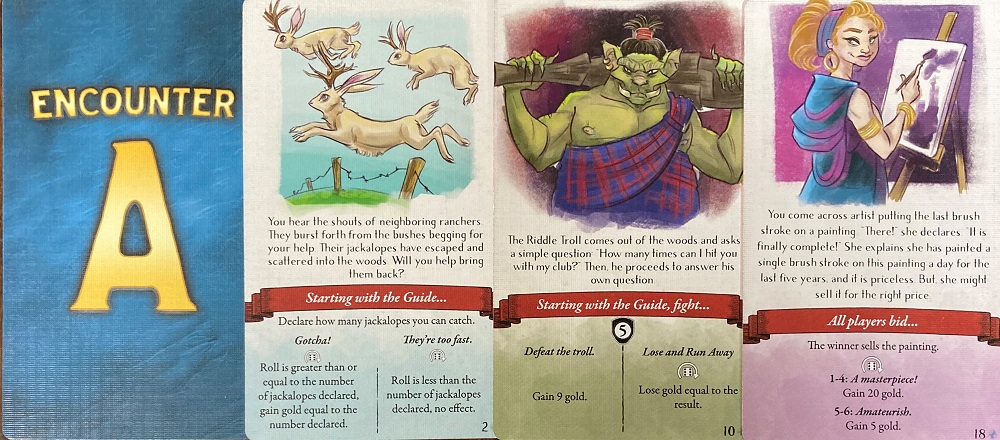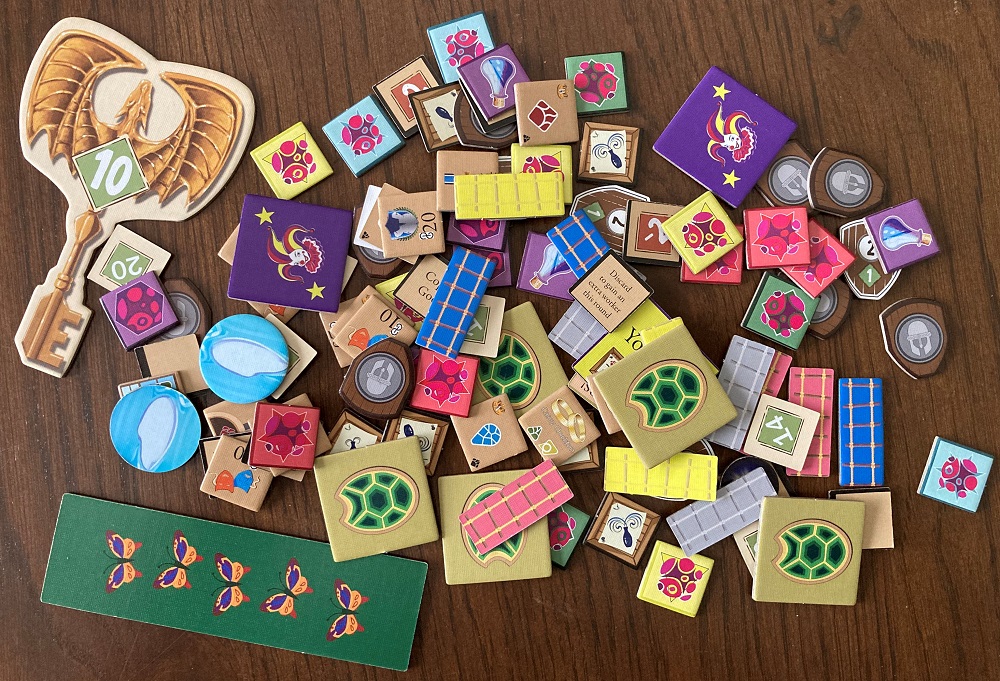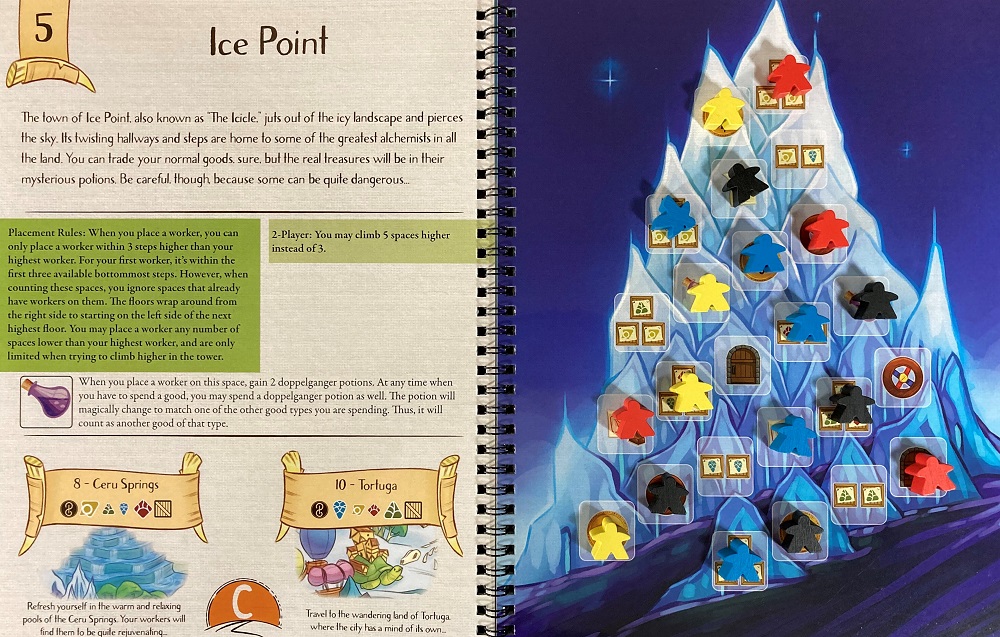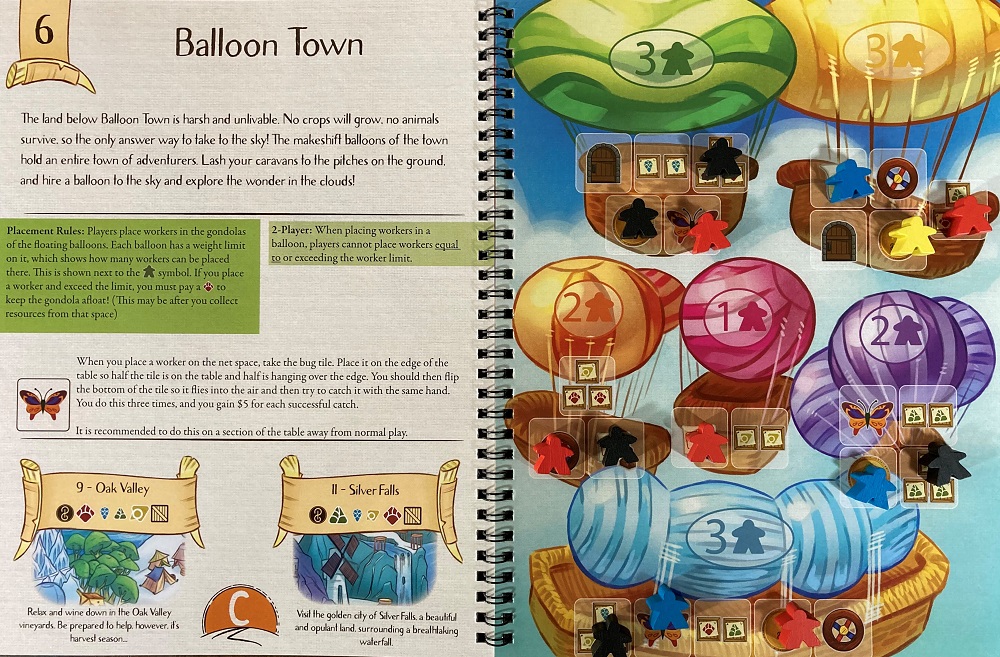Players first journeyed through Baeloria, a whimsical fantasy realm filled with adventure as well as danger, in Almanac: The Dragon Road. Now the caravans can continue on through the the frigid Crystal Peaks where they will visit strange places, acquire and sell goods, and face unpredictable encounters. The goal is to become the most famous merchant. Can you survive the dangers of the Crystal Peaks and gain the most fame along the way?
What Is Almanac: The Crystal Peaks?
Almanac: The Crystal Peaks is a worker placement game for 2-4 players, ages 12 and up, and takes about 60-90 minutes to play. It’s currently seeking funding on Kickstarter, with a pledge level of $49 for a copy of the base game. Almanac: The Crystal Peaks was designed by Scott Almes and published by Kolossal Games, with illustrations by Jacqui Davis. It is the stand-alone sequel to Almanac: the Dragon Road and has a familiar feel to veterans of the original. Included in Almanac: The Crystal Peaks is the Treacherous Trails pack. This encounter deck lets players play a game using the almanacs from both games for a truly epic journey.
Almanac: The Crystal Peaks Components
Here is what you get in the box:
- 120 Goods tokens (30 each of 4 types)
- 75 Gold tokens (4 different values)
- 30 Caravan cards
- 24 Contract cards
- 24 workers (6 per player color)
- 20 Encounter Cards
- 12 Guard tokens
- 1 Guide token
- 88 Location tokens
- 1 City Key token
- 4 player screens
- 4 Starting caravan cards
- 1 Almanac gamebook
- 1 6-sided die
- 1 Fight die
- 1 Rule book

The Almanac gamebook is the heart of Almanac: The Dragon Road. It acts as the gameboard during play. However, this gameboard changes, with 19 different pages each with its own play area. During a game, players will visit and play on only six different pages. The play area is located on the right side of the spread when the book is open with a storyline and specific rules for that location on the left side.

Each player begins with a starting caravan card. During the course of the game, players can purchase caravan cards to increase the carrying capacity of their caravan as well as to gain strength, workers, and/or fame. Caravan cards have squares printed on them to show where goods can be placed. Caravans cannot carry more goods than they have spaces.

Contracts are ways in which players can earn a lot of fame. Each player begins with two contracts and as they complete them, can gain more contracts. In order to complete a contract, players spend the turn in the required resources and perform a contract action. Contacts also have abilities they provide once completed. If you have uncompleted contract cards at the end of the game, you lose the fame points instead of gaining them.

As players move from one location to the next, they must play an encounter card. While there are 20 encounter cards, players only use five of them per game. Encounters can involve a fight with either a reward or a penalty depending on the outcome, or they can be an encounter where players make a choice of two outcomes.

Almanac: The Crystal Peaks includes lots of tokens. Many of these tokens represent the goods players trade and include the green Dewleaf, red Emberspice, blue Everice, and golden Skyfish. Gold tokens are used to purchase things as well as for bidding. They come in four different denominations: 1, 5, 20, and 50. Guard tokens can be purchased to increase the strength of your caravan during encounters and the Guide token is used to represent the first player. Several other tokens are specific to different locations your caravan will visit during their journey. Rules for their use are included in the Almanac gamebook.
Each player begins with three meeple workers which they use to take actions during gameplay. Players can gain up to three additional workers which provides them with additional actions. These worker meeples come in the four different player colors.
How to Play Almanac: The Crystal Peaks
The Goal
The goal of the game is to gain fame by completing contracts, selling goods, and building up your caravan.
Setup
Start off by placing the Almanac in the center of the play area and open to the first location called the Trader’s Village. All games start here. Shuffle the caravan deck and then the contract deck and place the decks facedown near the Almanac. Place the gold tokens in a supply and then separate the goods tokens by type and place them near the Almanac along with the Key to the City and guard tokens. Leave all the location tokens in the box but close by so you can access them as needed. Next, create the encounter deck by randomly selecting an encounter card from each letter, A-E. Stack these cards face down in alphabetical order so that the A card is on top. Return the remaining cards to the box.
Each player should take a player screen and six workers matching the player’s color. Players each take one starting caravan card and two contract cards from the deck. Place 3 workers on the caravan card in front of the player screen and keep the other three workers behind the screen. The youngest player is given the Guide token which designates the first player. The first player then is given 10 gold and going around in a clockwise direction, the other players receive 12, 14, and 16 gold respectively. You are now ready to begin to play.

Gameplay
A game of Almanac: The Crystal Peaks lasts 6 rounds with each round played at a different location within the Almanac. Players always start at the Trader’s Village and then progress through 5 other locations, each with their own challenges and special rules that apply only there. Many locations have special tokens that are used for that location or can be carried to other locations. Each game round is divided into three phases: the Arrival Phase, the Action Phase, and the End Phase.
Arrival Phase
When the players enter a new location, each player in turn order resolves all of their Arrival Phase abilities they have in their play area. Next, deal out a number of caravan cards from the deck equal to the number of players and place them face up near the Almanac. Now read the story text for the location as well as the setup and placement rules for the location and retrieve any components from the box as called for in the instructions.
Action Phase
Starting with the first player and continuing clockwise, each player places one worker from their caravan onto an available action space and resolve that action. Players continue this until all workers have been placed. Players can’t place workers from behind their screens. There are two types of action spaces: standard and location. Location actions are specific to each location while standard actions are available at all locations. There are six standard actions. Once a player has the required goods for a contract card, they can complete a contract by placing a worker on that space. Another action allows a player to gain a contract if they have less than 2 uncompleted contracts. For this, they draw three contract cards, pick one, and discard the other two. The extend your caravan action lets you purchase one of the caravan cards by paying the price listed on it. Gain goods actions let players take the goods shown on the space and place them onto their caravan as long as they have available space. By choosing a sell goods action, a player may sell as many of that specific type of good shown and receive the shown amount of gold per good. Finally, the visit the shop action lets a player choose one of three options: gain 1 good of their choice, discard goods of a single type for 3 gold each, or gain 1 guard token. Guard tokens provide two strength to a caravan and one fame point for the end of the game.

End Phase
Once all the players have placed all their workers and resolved their actions, players retrieve all their workers and return them to their caravan. Now players bid to be the guide which is the first player for the next round. Each player secretly takes gold from behind their screen and holds it in their hand. They can bid as much or as little as they want, even zero gold. When all players are ready, they simultaneously reveal their bid. The player with the highest amount of gold wins, but only pays the amount of the lowest bid. If someone bids zero gold, the winner still pays one gold. In case of a tie, the current Guide wins. If the current Guide was not involved in the tie, the player closest to the guide in turn order wins. The winner is given the Guide token.
The new Guide then selects the next location from the two choices at the bottom of the left page of the Almanac. Then the Guide reveals the top card of the encounter deck, reads the text, and tries to resolve it. If the Guide is unable to resolve it, then the next player in order attempts and so forth until the encounter is resolved. Finally, discard the encounter card, clean up any tokens from the location, discard any unpurchased caravan cards, and then turn the page of the Almanac to the chosen location. Start over with the arrival phase.
Game End
The game ends when players have used all of their available workers at their final destination of which there are four different and unique locations. Players have one last chance to complete any incomplete contracts still in their possession. They discard the required goods as usual but also have to pay 5 gold for each contract completed in this manner. Final scoring is determined by players calculating their fame. They receive one fame for each gold, the fame value of each caravan card, fame on location tokens, guards, and encounter cards they have acquired, and the fame value of completed contracts. The fame value of incomplete contracts is then subtracted from the total value. Goods on caravan cards provide no fame. The player with the most fame wins. In case of a tie, the player with the most gold wins. If still a tie, the player with the most goods in crates on their caravan cards wins.
Why You Should Play Almanac: The Crystal Peaks
Almanac: The Dragon Road was released earlier following a successful Kickstarter campaign in early 2020. I had the opportunity to play the first game and loved it. In fact, it is so good that it earned the GeekDad Approved designation and is in the running for 2021 Game of the Year. Therefore, when I first learned that there would be a sequel, I was extremely excited. The designer of Almanac: The Crystal Peaks, Scott Almes, has created a lot of different games including the Tiny Epic series. I am a fan of many of his games and Almanac: The Crystal Peaks is not exception. It provides a lot more variability than most worker placement games through the use of the Almanac. This essentially provides 19 different variations. Since you only use 6 locations during a game, rarely will two games be exactly alike as choices the players make during the game determine which locations you will use. Unlike the journey down the Dragon Road, Almanac: The Crystal Peaks has four different ending locations each with interesting and unique challenges. The locations at the start of the game are fairly straight-forward. Place your worker and resolve the action. However, as you get closer to the end, more strategy is involved in placing your workers. Sometimes you can’t place your workers in adjacent spaces or other limitations affect your choices. Some even depend on yours opponents’ placement of workers. Since players start with only 3 workers and can build up to only 6, the game moves quickly, spending only about 10 minutes on each location.

A key to winning the game is buying caravan cards to increase the size of your caravan as well as your workforce. The more workers you have, the more actions you can take during a round. While building up your caravan, you also need to be working to complete contracts, gaining goods, and trying to make gold which you need for caravan cards as well as bidding. I enjoyed the need to balance your actions since you want to get lots of good, but need space in your caravan to carry them. Then do you sell the goods for gold or use them for contracts? Whether you win or lose a game, you want to play again to try new strategies.

Many new players not realize the importance of bidding to become the Guide or first player. This role has many advantages. First, you get to pick the next location. Next to your choices on the page of the Almanac is information that shows which goods are more available at each location as well as which sells for the most. Therefore, the Guide can pick a location with goods they need for their contracts or if they want to sell goods, the choice that provides the most likely profit. The Guide also gets the first chance at the encounter, which if they can resolve it, they get the reward. Finally, getting to choose actions first at the new location provides a great advantage. Even the bidding mechanic requires some strategy. You may want to bid a lot to win, hoping that others choose not to bid much since you only pay the lowest bid with a minimum cost of 1 gold. Therefore, even if you don’t have enough gold to win, you can make the winner pay more by not bidding low. While I love the worker placement part of the game, the bidding is just as fun and a great change to the gameplay in-between each location.
Almanac: The Crystal Peaks is an incredible game. Even though we have played Almanac: The Dragon Road, my family had a great time playing the sequel and found the new locations and challenges entertaining. The gameplay, the art and look of the game, the replayability, and the great blend of mechanics make this an incredible game that you will want to add to your collection whether you have the earlier game or not. This game is great for playing with children as well as for adult game groups. For these reasons, I highly recommend Almanac: The Crystal Peaks.
For more information or to make a pledge, visit the Almanac: The Crystal Peaks Kickstarter page!
Click here to see all our tabletop game reviews.
![]() To subscribe to GeekDad’s tabletop gaming coverage, please copy this link and add it to your RSS reader.
To subscribe to GeekDad’s tabletop gaming coverage, please copy this link and add it to your RSS reader.
Disclosure: GeekDad received a copy of this game for review purposes.





